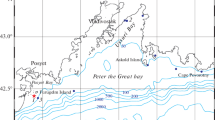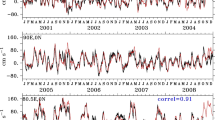Abstract
In southwest Western Australia, strong and persistent sea breezes are common between September and February. We hypothesized that on the inner continental shelf, in the absence of tidal forcing, the depth, magnitude, and lag times of the current speed and direction responses to sea breezes would vary though the water column as a function of the sea breeze intensity. To test this hypothesis, field data were used from four sites were that were in water depths of up to 13 m. Sites were located on the inner continental shelf and were on the open coast and in a semi-enclosed coastal embayment. The dominant spectral peak in currents at all sites indicated that the majority of the spectral energy contained in the currents was due to forcing by sea breezes. Currents were aligned with the local orientation of the shoreline. On a daily basis, the sea breezes resulted in increased current speeds and also changed the current directions through the water column. The correlation between wind–current speeds and directions with depth, and the lag time between the onset of the sea breeze and the response of currents, were dependent on the intensity of the sea breezes. A higher correlation between wind and current speeds occurred during strong sea breezes and was associated with shorter lag times for the response of the bottom currents. The lag times were validated with estimates of the vertical eddy viscosity. Solar heating caused the water column to stratify in summer and the sea breezes overcame this stratification. Sea breezes caused the mixed layer to deepen and the intensity of the stratification was correlated to the strength of the sea breezes. Weak sea breezes of <5 m s−1 were associated with the strongest thermal stratification of the water column, up to 1°C between the surface and bottom layers (6 and 10 m below the surface). In comparison, strong sea breezes of >14 m s−1 caused only slight thermal stratification up to 0.5°C. Apart from these effects on the vertical structure of water column, the sea breezes also influenced transport and mixing in the horizontal dimension. The sea breezes in southwest Western Australia rotated in an anticlockwise direction each day and this rotation was translated into the currents. This current rotation was more prominent in surface currents and in the coastal embayment compared to the open coast.










Similar content being viewed by others
References
Abbs DJ, Physick WL (1992) Sea-breeze observations and modelling: a review. Aust Meteorol Mag 41:9–19
Bowden KF, Fairbairn LA, Hughes P (1959) The distribution of shearing stresses in a tidal current. Geophys J Roy Astron Soc 2(4):288–305
Cambridge ML, McComb AJ (1984) The loss of seagrasses in Cockburn Sound, Western Australia. 1. The time course and magnitude of seagrass decline in relation to industrial development. Aquat Bot 20:229–243
Craig PD (1989a) Constant eddy-viscosity models of vertical structure forced by periodic winds. Cont Shelf Res 9:343–358
Craig PD (1989b) A model of diurnally forced vertical current structure near 30º latitude. Cont Shelf Res 9:965–980
D’Adamo (2002) Exchange and mixing in Cockburn Sound, Western Australia: a seasonally stratified, micro-tidal, semi-enclosed coastal embayment. PhD Thesis, University of Canterbury, Christchurch, New Zealand
Department of Defence (2011) Australian national tide tables 2011. Australian Hydrographic, Canberra
DiMarco SF, Howard MK, Reid RO (2000) Seasonal variation of wind-driven diurnal current cycling on the Texas–Louisiana continental shelf. Geophys Res Lett 27(4):1017–1020
Gallop SL, Bosserelle C, Pattiaratchi C, Eliot I (2011) Rock topography causes spatial variation in the wave, current and beach response to sea breeze activity. Mar Geol 290:29–40
Geyer R, Trowbridge JH, Bowen MM (2000) The dynamics of a partially mixed estuary. J Phys Oceanogr 30:2035–2048
Hakanson L (2006) Suspended particulate matter in lakes, rivers and marine systems. Blackburn, New Jersey
Hansen PS, Philips EJ, Aldrige FJ (1997) The effects of sediment resuspension on phosphorus available for algal growth in a shallow subtropical lake, Lake Okeechobee. Lake Reservoir Manag 13:154–159
Hyder P, Simpson JH, Christopoulos S (2002) Sea-breeze forced diurnal surface currents in the Thermaikos Gulf, North-west Aegean. Cont Shelf Res 22:585–601
Kepert JD, Smith RK (1992) A simple model of the Australian West Coast Trough. Mon Weather Rev 120:2042–2055
Kiørboe T (1993) Turbulence, phytoplankton cell size, and the structure of pelagic food webbs. Adv Mar Biol 29:1–72
Lawrence DL, Dagg MJ, Liu H, Cummings SR, Ortner PB, Kelble C (2004) Wind events and benthic–pelagic coupling in a shallow subtropical bay in Florida. Mar Ecol Prog Ser 266:1–13
Masselink G (1996) Sea breeze activity and its effect on coastal processes near Perth, Western Australia. J Roy SoC West Aust 79:199–205
Masselink G, Pattiaratchi CB (2001a) Characteristics of the sea breeze system in Perth Western Australia, and its effect on the near shore wave climate. J Coastal Res 17(1):173–187
Masselink G, Pattiaratchi CB (2001b) Seasonal changes in beach morphology along the sheltered coastline of Perth, Western Australia. Mar Geol 172:243–263
Pattiaratchi CB, Eliot I (2009) Sea level variability in south-west Australia: from hours to decades. Coast Eng, Proceedings of the International Coastal Engineering Conference. ASCE 1186–1198
Pattiaratchi CB, Woo M (2009) The mean state of the Leeuwin Current system between North West Cape and Cape Leeuwin. J Roy SoC West Aust 92:221–241
Pattiaratchi C, Hegge B, Gould J, Eliot I (1997) Impact of sea-breeze activity on nearshore and foreshore processes in southwestern Australia. Cont Shelf Res 17(13):1539–1560
Pearce A, Pattiaratchi C (1999) The Capes Current: a summer countercurrent flowing past Cape Leeuwin and Cape Naturaliste, Western Australia. Cont Shelf Ref 19:401–420
Peterson EW, Hennessey JP Jr (1978) On the use of power laws for estimates of wind power potential. J Appl Meteorology 17:390–394
Simpson JH, Brown J, Matthews J, Allen G (1990) Tidal straining, density currents, and stirring in the control of estuarine circulation. Estuaries 13:125–132
Simpson JH, Hyder P, Rippeth TP (2002) Forced oscillations near the critical latitude for diurnal–inertial resonance. J Phys Oceanogr 32:177–187
Sobarzo M, Bravo L, Moffat C (2010) Diurnal-period, wind-forced ocean variability on the inner shelf off Concepción, Chile. Cont Shelf Res 30(20):2043–2056
Steedman RK, Craig W (1983) Wind-driven circulation of Cockburn Sound. Aust J Mar Fresh Res 34:187–212
Tapper N, Hurry L (1993) Australia's weather patterns: an introductory guide. Dellasta, Victoria
Thompson P, Waite A (2003) Phytoplankton responses to wastewater discharges at two sites in Western Australia. Mar Fresh Res 54(18):721–735
Verspecht F, Pattiaratchi C (2010) On the significance of wind event frequency for particulate resuspension and light attenuation in coastal waters. Cont Shelf Res 30(18):1971–1982
Verspecht F, Rippeth TP, Simpson JH, Souza AJ, Burchard H, Howarth M (2009) Residual circulation and stratification in the Liverpool Bay region of freshwater influence. Ocean Dyn 59:765–779
Zaker NH, Imberger J, Pattiaratchi C (2002) Numerical simulation of the coastal boundary later off Perth, Western Australia. J Coastal Res 18(3):470–485
Zaker NH, Imberger J, Pattiaratchi C (2007) Dynamics of the coastal boundary layer off Perth, Western Australia. J Coastal Res 23(5):1112–1130
Zhang X, DiMarco SF, Smith DC IV, Howard MK (2009) Near-resonant ocean response to sea breeze on a stratified continental shelf. J Phys Oceanogr 39:2137–2155
Acknowledgements
This work was undertaken by SLG as part of a PhD at The University of Western Australia and was partly funded by the Samaha Research Scholarship and the Western Australian Marine Science Institution (WAMSI, project 6.1). Thank you to the Australian Bureau of Meteorology for supplying wind data and Dr. David Luketina from the Water Corporation (WA) for allowing us to use field data from Binningup. Thank you to Cyprien Bosserelle, Dennis Stanley, Tanya Stul and Clint Winant for their assistance, and to Carey Conn for editing the manuscript. Finally, thank you to the anonymous reviewers for their constructive comments.
Author information
Authors and Affiliations
Corresponding author
Additional information
Responsible Editor: Chari Pattiaratchi
This article is part of the Topical Collection on Physics of Estuaries and Coastal Seas 2010
Rights and permissions
About this article
Cite this article
Gallop, S.L., Verspecht, F. & Pattiaratchi, C.B. Sea breezes drive currents on the inner continental shelf off southwest Western Australia. Ocean Dynamics 62, 569–583 (2012). https://doi.org/10.1007/s10236-011-0515-3
Received:
Accepted:
Published:
Issue Date:
DOI: https://doi.org/10.1007/s10236-011-0515-3




